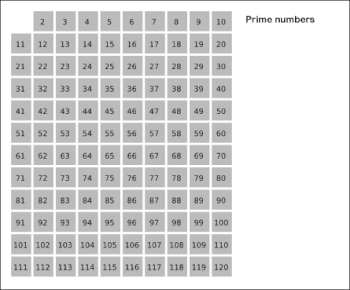2521. Distinct Prime Factors of Product of Array
- Hardness:
- Ralated Topics:
一、題目
Given an array of positive integers nums, return the number of distinct prime factors in the product of the elements of nums.
Note that:
- A number greater than
1is called prime if it is divisible by only1and itself. - An integer
val1is a factor of another integer val2 ifval2 / val1is an integer.
Example 1:
- Input: nums = [2,4,3,7,10,6]
- Output: 4
- Explanation:
The product of all the elements in nums is: 2 * 4 * 3 * 7 * 10 * 6 = 10080 = 2^5 * 3^2 * 5 * 7.
There are 4 distinct prime factors so we return 4.
Example 2:
- Input: nums = [2,4,8,16]
- Output: 1
- Explanation:
The product of all the elements in nums is: 2 * 4 * 8 * 16 = 1024 = 210.
There is 1 distinct prime factor so we return 1.
Constraints:
1 <= nums.length <= 10^42 <= nums[i] <= 1000
二、分析
- 這一題是要求所有數字相乘的質因數分解,並求質因數的個數。
- 我們並不需要真的將所有數字相乘,因為我們的目的是要將之作因數分解,而分解的過程中,可能會重複檢查到每個數字是否為質因數,為了避免重複檢查,可以將檢查過的數,用
dp的方式記錄起來。或者是用pre-built table的方式,將是否為質數先計算出來。 - 此題我用的方法是數論中,從
2開始依序由小到大將倍數篩掉,此法有個很長的名子叫作Sieve of Eratosthenes。
- 我們只需把
pre-built table做到數列的最大值。 - 在此我做了一個改版,我們將這個 table 記錄下最小的因數,方便做因數分解,這個 table 的特性是:
- 當
table[i] == i時,i為質數。 - 當
table[i] != i時,table[i]為i最小的質因數。
- 當
- 以下是原始的
table: - 改良後的
table: - 有了上面這張改良後的表,因式分解就可以簡化成:
- 當
table[num] == num時,num是質數 - 否則
num = table[num] * num/table[num],由於table[num]是最大因數,所以可以繼續分解直到變成質數。
- 當
三、解題
1. Sieve of Eratosthenes
- Time complexity:
- Space complexity:
vector<int> table; // 在全域建一個 pre-built table
int distinctPrimeFactors(vector<int>& nums) {
int upbound = *max_element(nums.begin(), nums.end()); // 求整個數列的最大值
table.assign(upbound+1, 0); // table 只需求到最大值即可
iota(table.begin(), table.end(), 0); // 依序將 table[i] = i 填入 table
for (int i = 2; i <= upbound; i++) {
if (!table[i]) continue; // 當該數為合數時,跳過
for (int j = 2*i; j <= upbound; j += i) {
table[j] = i; // 將所有質數的倍數記錄下他
}
}
unordered_set<int> set;
for (const auto& num : nums) {
find(num, set); // 質因數分解
}
return set.size(); // 求質因數的個數
}
void find(int num, unordered_set<int>& set) {
if (table[num] == num) {
set.insert(num); // 當是質數就用 set 記錄下來
} else {
find(num/table[num], set); // 不是質數就繼續分解
find(table[num], set);
}
}